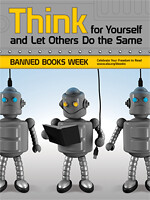Seth Grahame-Smith
What do you do as an encore after writing a bestseller and trend setter like Pride and Prejudice and Zonbies ? Seth Graham-Smith has turned from Jane Austen to Abraham Lincoln.
The premise of the book is that Lincoln has been spending his nights, since the age of 12, when his mother was killed by a vampire, hunting and destroying the undead. Somehow nobody ever noticed all the corpses with wooden stakes through their hearts or their heads chopped off lying around Indiana, Illinois and up and down the Illinois, Ohio and Missippi rivers, all the way to New Orleans.
Vampires are also held responsible for slavery in the book. It seems that slave owners have been making a profit selling their excess, old and infirm or simply weak slaves to vampires for consumption. In fact some southern plantations are owned and occupied by vampires. You can tell them by the parasols and the dark glasses, which they wear to protect themselves from the sun. In this book vampires fought in the Confederate army and John Wilkes Booth was a vampire.
August is traditionally silly season and Abraham Lincoln Vampire Hunter is a silly book. It is also well written and entertaining in it's own silly, if gruesome, way. Thanks to Graham-Smith, we now can enjoy titles like Adventures of Huckleberry Finn and Zombies
, The Undead World of Oz
, Sense and Sensibility and Sea Monsters
, Mansfield Park and Mummies
, Emma and the Werewolves
and Android Karenina
not to mention Zombie Economics
, Zombie Capitalism. We have also been treated to op-ed pieces like All The President's Zombies, in the New York Times and Night of the Living Wonks in Foreign Policy (soon to be expanded into a book) When Will It Stop?
Tuesday, August 17, 2010
Abraham Lincoln Vampire Hunter
Friday, August 6, 2010
In Big Trouble
Laura Lippman
Laura Lippman is a reliable novel producing machine, turning out a book a year, year in and year out and her Tess Monaghan series of crime novels never disappoints. It is a stoke of luck that Lippman has a backlog of Tess Monaghan stories that were originally published only in mass market paperback and which are now seeing the light of day under hard covers, effectively doubling her published output.
In Big Trouble is one of these. It fits in chronologically between Butcher's Hill and The Sugar House and helps to cement Tess' relationship with her musician boyfriend, Crow Ransome. Crow has left Baltimore and gone to Texas to pursue his musical ambitions in the thriving Austin music scene.
The novel draws Tess away from Baltimore to San Antonio, Texas, where Lippman worked as a journalist before returning o Maryland to work at the Blight, I mean the Sunpapers. This gives Lippman a chance to show off another city that she knows well.
There are a few small bobbles, plotwise, in the book. Tess is drawn to Texas by a mysterious envelope containing a picture of Crow cut out of a newspaper with the words "In Big Trouble" printed over his head. It turns out hat this is part of a publicity shot for his new Texas band, which has left Austin for San Antonio. Who sent it and why? Late in the book Lippman flatly states that Crow did but gives no explanation, yet this is the impetus for the entire string of events. He couldn't write and say, hey we've got a bit of a problem here? It's not even clear that Crow wanted Tess' help.
The San Antonio police have a warrant for Crow's arrest at one point but the only evidence they have is a shotgun tat the find in an illegal search of his room after they execute the warrant. How did they get the warrant?
Despite thes errors in plotwriting, In Big Trouble is an enjoyable read. You are unlikely to guess who done it. Actually, as in many of Lippman's books, you are unlikely to gues what was actually done.
***************
Keywords: crime fiction, Laura Lippman, Tess Monaghan









